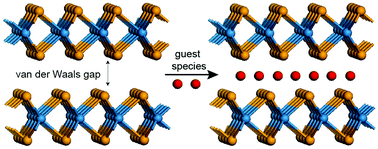Intercalation in two-dimensional transition metal chalcogenides
Abstract
Intercalation is a reversible insertion process of foreign species into crystal gaps. Layered materials are good host materials for various intercalant species ranging from small ions to atoms to molecules. Given the recent intense interest in two-dimensional (2D) layered materials in thin limits, this review highlights the opportunities that intercalation chemistry can provide for nanoscale layered materials. Novel heterostructures or emergent electrical properties not found in the intrinsic host materials are possible with intercalation. In particular, we review various exfoliation methods developed for 2D layered nanomaterials based on intercalation chemistry and extensive tuning of the electrical, optical, and magnetic properties of 2D layered materials due to intercalation.

- This article is part of the themed collections: 2016 Inorganic Chemistry Frontiers Review-type Articles and 2015 Emerging Investigators by ICF

 Please wait while we load your content...
Please wait while we load your content...